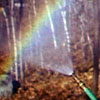-

-
Courses
Find courses by:
Collections
Cross-Disciplinary Topic Lists
- About
- Donate
- Featured Sites

 |
|
By the end of this lecture, you should:
› View/hide answer
This bow would have \[{\cos ^2}\left( {{i_{{\varphi _{\max }}}}} \right) = \frac{{{n^2} - 1}}{3} = \frac{{{{1.628}^2} - 1}}{3} = 0.5501\] Thus \(\cos \left( {{i_{{\varphi _{\max }}}}} \right) = 0.7417\)or \({i_{{\varphi _{\max }}}} = 42.1^\circ \). The value of \({\varphi _{\max }}\) itself is close to the angular radius of the bow. From Snell’s Law at the point of entry \({n_1}\sin i = {n_2}\sin r\) or \[r = {\sin ^{ - 1}}\left( {\frac{{{n_1}\sin i}}{{{n_2}}}} \right) = {\sin ^{ - 1}}\left( {\frac{{1\sin (42.1)}}{{1.628}}} \right) = 24.3^\circ \] Finally, \[\varphi = 4r - 2i = 4(24.3) - 2(42.1) = 13^\circ \] Since the glassbow (n = 1.5) was of radius 22º, this yet smaller result for higher index seems reasonable.
P.S. One of the reasons for the impossibility of a "diamond-bow" is that the material is too refractive to make a rainbow in the manner described.
› View/hide answer
This bow would have \[{\cos ^2}\left( {{i_{{\varphi _{\max }}}}} \right) = \frac{{{n^2} - 1}}{3} = \frac{{{{1.5}^2} - 1}}{3} = 0.4167\] Thus \(\cos \left( {{i_{{\varphi _{\max }}}}} \right) = 0.6455\) or \({i_{{\varphi _{\max }}}} = 49.8^\circ \). The angular radius φ was given in the lectures as 22.8º, so \[r = \frac{{\varphi + 2i}}{4} = \frac{{22.8 + 2(49.8)}}{4} = 30.6^\circ \] The situation is quite like in the drawing made in the lecture, except with the right hand side being the bottom of the tray. Point B would not touch the bottom. When the water had not yet risen to the level of point B, nothing significant would happen. Once B was covered, there would be less contrast of the indices of refraction inside and out. Looking back at the Fresnel equations, the ones for reflection basically increase with difference of refractive index, so less difference would give less reflection. The glassbow would dim noticeably once the water went past point B, but this situation would not change much as the water got deeper, until it reached point C. Above that, the problem gets more complicated since the refraction of the light out of the bead would change (glass to water instead of glass to air) and then the light would need to refract out of the water into the air.
› View/hide answer
The exact central beam has normal incidence, and for water the amplitude ratio for either polarization (there is no difference) reduces to \[\frac{{{E_r}}}{{{E_i}}} = \frac{{{n_1} - {n_2}}}{{{n_1} + {n_2}}} = \frac{{1 - 1.33}}{{1 + 1.33}} = \frac{{ - .33}}{{2.33}} = - .1416.\] Squaring this, about 2% of the light is reflected and 98% gets through. The ratio is the same at the other side of the drop where this light exits, so about 96% of the light passes straight through. Strictly speaking, we should account for multiple reflections, but this will be a small effect. From the back the drops will appear bright in the middle and darker toward the outside. The dark part is where the rainbow went back toward the front! The main effect the transmitted light would have on the rainbow would be to go on to other drops and allow them to send light back to add to the rainbow.